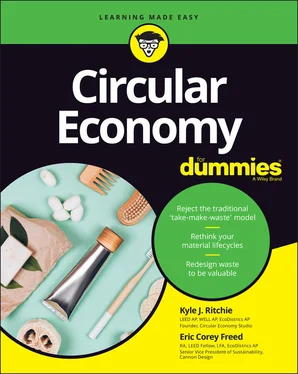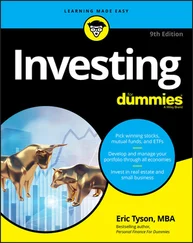Accelerating the transition
It is abundantly clear that there is an urgent need to shift away from our current linear economy toward a circular economy that is restorative and regenerative. The first steps of this shift are already being taken by pioneering businesses and governments, but the time has now come to accelerate and scale the transition rapidly across all corners of the global economy. Enabled by digital technologies, business models, products and services, policies, and infrastructure all need to be redesigned in line with circular economy principles if we are to create an entirely new system that benefits the economy, society, and the environment.
Rethinking Material Lifecycles
Once you identify zero waste as a real possibility for the future, you need to make a number of adjustments to all areas of a material’s lifecycle — the various steps that take place during its sourcing, use, and recovery. To understand what opportunities are available to create a waste-free future, you first need to analyze where current lifecycles stand and where waste is generated. From there, you can incorporate conservation methods, efficient use, and proper regeneration of materials as part of your product lifecycle.
Current lifecycles rely on a linear processing of materials. Here, materials are extracted from the environment, made into products, and later sent to landfills or incinerated when the product no longer serves a function. This lack of proper management causes valuable resources to be lost forever and further drives the need to extract new and raw materials from the environment. It’s so unnecessary to throw things away, because every material — if properly managed — can be recaptured and applied to serve another purpose.
 Though different materials require different management strategies, the opportunities are not only available but also clear. Whether it’s developing a community sharing network, localized repair centers, or a dedicated community workspace to upcycle or downcycle faulty products, the opportunities to eliminate waste are available if members of the global economy take the time to rethink how to manage material lifecycles.
Though different materials require different management strategies, the opportunities are not only available but also clear. Whether it’s developing a community sharing network, localized repair centers, or a dedicated community workspace to upcycle or downcycle faulty products, the opportunities to eliminate waste are available if members of the global economy take the time to rethink how to manage material lifecycles.
The linear way of managing resources is built on the notion that waste is inevitable and acceptable. In this style of resource management, raw materials are taken from the earth and made into products and eventually wind up as waste. These three major milestones of a lifecycle don’t stand isolated from the others, either, but fuel one another.
If waste is an assumed part of a lifecycle, there’s motivation to ensure that the materials that are sourced to make the product are as cheap as possible and the product itself is designed to last only a short amount of time. Keeping costs low also incentivizes the user of those products to dispose of them at the end of their useful life rather than repair them. You wouldn’t try to repair a plastic fork when it breaks. You’d throw it away and go find another one. Using cheap materials and making cheap products fuels the purchase of new products and maintains a consistent supply/demand relationship between manufacturers and customers.
Rethinking material lifecycles can transform the conventional take-make-waste approach toward a new management focused on eliminating waste as a necessity; making long-lasting, resilient products; and regenerating the natural systems on which the human race is dependent.
 Rethinking (and improving on) a material lifecycle requires that you identify every element of the cycle. The more details you can identify, the more opportunities you’ll find to improve the lifecycle. First analyze the entire lifecycle, and then find opportunities to conserve resources, increase the efficiency of how those materials are used, and, finally, explore how those materials can be recaptured at the end of their useful life.
Rethinking (and improving on) a material lifecycle requires that you identify every element of the cycle. The more details you can identify, the more opportunities you’ll find to improve the lifecycle. First analyze the entire lifecycle, and then find opportunities to conserve resources, increase the efficiency of how those materials are used, and, finally, explore how those materials can be recaptured at the end of their useful life.
Making technical materials circular
Technical materials are those that cannot be grown. Metals, plastics, and other finite materials are in limited supply and must be managed accordingly. To keep technical materials in use for longer periods, we humans need to harness new strategies. Although recycling technical materials is better than disposing of them, recycling should be seen as a last resort when considering circular materials management. Sharing, reusing, repairing, and remanufacturing products are all resource management strategies that should be employed before recycling.
One major issue in making technical materials circular is that the current products we use aren’t often designed to allow for sharing, reuse, repair, or remanufacturing. The innate capability of products to do all those things will need to be designed into the product itself. Unless this happens, it’s quite challenging to support a circular lifecycle, and recycling becomes the only option. For circular lifecycles to become a reality when it comes to technical materials, a proper support infrastructure needs to be in place to allow for sharing, reuse, repair, and remanufacturing to take place. Look around the room and find something made of technical materials. If the item stopped working right now, would you easily be able to have it repaired? Or would it be easier to simply throw it away and buy a new one? This reality also supports the notion that consumers must have an incentive to support a circular economy, because they have the incentive now to support a linear economy by way of low prices and convenience.
Making biological materials circular
The main difference between technical materials and biological materials is that biological materials can be regenerated or grown from the earth. Metals, plastics, and other technical materials are finite and cannot be regenerated. Cotton, timber, and other biological materials can be regenerated, which greatly affects how their lifecycles must be managed within a circular economy. Biological materials can be kept in use for longer periods by allowing the materials themselves to cascade — repurposing from a high-value product to a low-value product. Once the material can no longer serve a function, the biochemical feedstock of that material can be extracted as heat or energy, and the remaining organic material can be utilized as nutrients to fuel the growth of more biological materials.
Cascading keeps biological materials in use for longer periods. Doing so increases the value of that material. For example, rather than cut down a tree and process the fiber to become a piece of paper (low-value product), the tree should be made into something of high-value first, such as a building structure. From there, after it no longer can serve as a building structure, it can cascade into a lower-value product, such as a table or plywood. From there, it can cascade even further to the lowest-value product possible, like a piece of paper. Because a product becomes more valuable the longer it maintains its use, cascading materials acts as a strategy to maximize the value of the biological materials extracted from the earth.
Once that piece of paper has been used, it may seem like waste at this point. It can’t be used as paper again, and it certainly can’t act as a building structure. However, the material itself has an innate value that can be biochemically extracted. Paper can be incinerated to create heat, or the fibers of the paper can be recycled into new paper. Whatever the future of that piece of paper may be, it’s critical to never see it as waste. There is always the embodied value of a material.
Читать дальше

 Though different materials require different management strategies, the opportunities are not only available but also clear. Whether it’s developing a community sharing network, localized repair centers, or a dedicated community workspace to upcycle or downcycle faulty products, the opportunities to eliminate waste are available if members of the global economy take the time to rethink how to manage material lifecycles.
Though different materials require different management strategies, the opportunities are not only available but also clear. Whether it’s developing a community sharing network, localized repair centers, or a dedicated community workspace to upcycle or downcycle faulty products, the opportunities to eliminate waste are available if members of the global economy take the time to rethink how to manage material lifecycles. Rethinking (and improving on) a material lifecycle requires that you identify every element of the cycle. The more details you can identify, the more opportunities you’ll find to improve the lifecycle. First analyze the entire lifecycle, and then find opportunities to conserve resources, increase the efficiency of how those materials are used, and, finally, explore how those materials can be recaptured at the end of their useful life.
Rethinking (and improving on) a material lifecycle requires that you identify every element of the cycle. The more details you can identify, the more opportunities you’ll find to improve the lifecycle. First analyze the entire lifecycle, and then find opportunities to conserve resources, increase the efficiency of how those materials are used, and, finally, explore how those materials can be recaptured at the end of their useful life.










